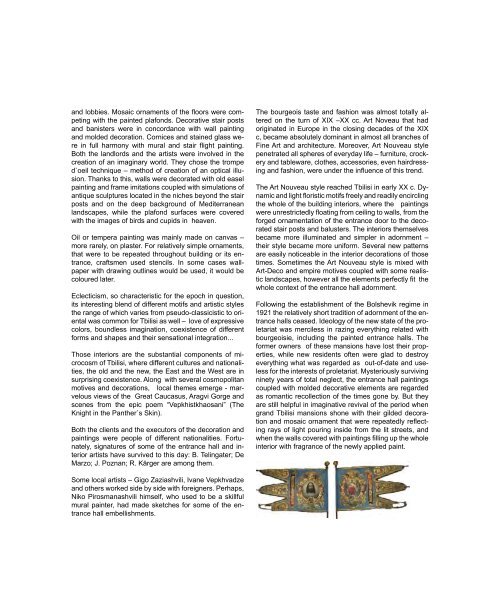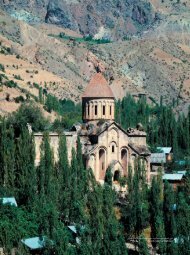Charm of Tbilisi Tbilisis xibli
Charm of Tbilisi Tbilisis xibli
Charm of Tbilisi Tbilisis xibli
Create successful ePaper yourself
Turn your PDF publications into a flip-book with our unique Google optimized e-Paper software.
and lobbies. Mosaic ornaments <strong>of</strong> the floors were competing<br />
with the painted plafonds. Decorative stair po sts<br />
and banisters were in concordance with wall painting<br />
and molded decoration. Cornices and stained glass were<br />
in full harmony with mural and stair flight painting.<br />
Both the landlords and the artists were involved in the<br />
creation <strong>of</strong> an imaginary world. They chose the trompe<br />
d`oeil technique – method <strong>of</strong> creation <strong>of</strong> an optical illusion.<br />
Thanks to this, walls were decorated with old easel<br />
painting and frame imitations coupled with simulations <strong>of</strong><br />
antique sculptures located in the niches beyond the stair<br />
posts and on the deep background <strong>of</strong> Mediterranean<br />
landscapes, while the plafond surfaces were covered<br />
with the images <strong>of</strong> birds and cupids in heaven.<br />
Oil or tempera painting was mainly made on canvas –<br />
more rarely, on plaster. For relatively simple ornaments,<br />
that were to be repeated throughout building or its entrance,<br />
craftsmen used stencils. In some cases wallpaper<br />
with drawing outlines would be used, it would be<br />
coloured later.<br />
Eclecticism, so characteristic for the epoch in question,<br />
its interesting blend <strong>of</strong> different motifs and artistic styles<br />
the range <strong>of</strong> which varies from pseudo-classicistic to oriental<br />
was common for <strong>Tbilisi</strong> as well – love <strong>of</strong> expressive<br />
colors, boundless imagination, coexistence <strong>of</strong> different<br />
forms and shapes and their sensational integration...<br />
Those interiors are the substantial components <strong>of</strong> microcosm<br />
<strong>of</strong> <strong>Tbilisi</strong>, where different cultures and nationalities,<br />
the old and the new, the East and the West are in<br />
surprising coexistence. Along with several cosmopolitan<br />
motives and decorations, local themes emerge - marvelous<br />
views <strong>of</strong> the Great Caucasus, Aragvi Go rge and<br />
scenes from the epic poem “Vepkhistkhaosani” (The<br />
Knight in the Panther`s Skin).<br />
Both the clients and the executors <strong>of</strong> the decoration and<br />
paintings were people <strong>of</strong> different nationalities. Fortunately,<br />
signatures <strong>of</strong> some <strong>of</strong> the entrance hall and interior<br />
artists have survived to this day: B. Telingater; De<br />
Marzo; J. Poznan; R. Kärger are among them.<br />
Some local artists – Gigo Zaziashvili, Ivane Vepkhvadze<br />
and others worked side by side with foreigners. Perhaps,<br />
Niko Pirosmanashvili himself, who used to be a skillful<br />
mural painter, had made sketches for some <strong>of</strong> the entrance<br />
hall embellishments.<br />
The bourgeois taste and fashion was almost totally altered<br />
on the turn <strong>of</strong> XIX –XX cc. Art Noveau that had<br />
originated in Europe in the closing decades <strong>of</strong> the XIX<br />
c, became absolutely dominant in almost all branches <strong>of</strong><br />
Fine Art and architecture. Moreover, Art Nouveau style<br />
penetrated all spheres <strong>of</strong> everyday life – furniture, crockery<br />
and tableware, clothes, accessories, even hairdressing<br />
and fashion, were under the influence <strong>of</strong> this trend.<br />
The Art Nouveau style reached <strong>Tbilisi</strong> in early XX c. Dynamic<br />
and light floristic motifs freely and readily encircling<br />
the whole <strong>of</strong> the building interiors, where the paintings<br />
were unrestrictedly floating from ceiling to walls, from the<br />
forged ornamentation <strong>of</strong> the entrance door to the decorated<br />
stair posts and balusters. The interiors themselves<br />
became more illuminated and simpler in adornment –<br />
their style became more uniform. Several new patterns<br />
are easily noticeable in the interior decorations <strong>of</strong> those<br />
times. Sometimes the Art Nouveau style is mixed with<br />
Art-Deco and empire motives coupled with some realistic<br />
landscapes, however all the elements perfectly fit the<br />
whole context <strong>of</strong> the entrance hall adornment.<br />
Following the establishment <strong>of</strong> the Bolshevik regime in<br />
1921 the relatively short tradition <strong>of</strong> adornment <strong>of</strong> the entrance<br />
halls ceased. Ideology <strong>of</strong> the new state <strong>of</strong> the proletariat<br />
was merciless in razing everything related with<br />
bourgeoisie, including the painted entrance halls. The<br />
former owners <strong>of</strong> these mansions have lost their properties,<br />
while new residents <strong>of</strong>ten were glad to destroy<br />
everything what was regarded as out-<strong>of</strong>-date and useless<br />
for the interests <strong>of</strong> proletariat. Mysteriously surviving<br />
ninety years <strong>of</strong> total neglect, the entrance hall paintings<br />
coupled with molded decorative elements are regarded<br />
as romantic recollection <strong>of</strong> the times gone by. But they<br />
are still helpful in imaginative revival <strong>of</strong> the period when<br />
grand <strong>Tbilisi</strong> mansions shone with their gilded decoration<br />
and mosaic ornament that were repeatedly reflecting<br />
rays <strong>of</strong> light pouring inside from the lit streets, and<br />
when the walls covered with paintings filling up the whole<br />
interior with fragrance <strong>of</strong> the newly applied paint.



